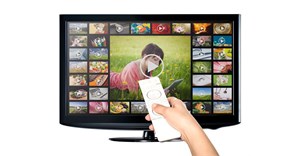
Screen Wars: The battle for eye space in a TV everywhere world
The report examines the rapidly developing global digital video landscape and shows how consumers are adapting their viewing preferences to a new reality, where more than three-quarters (86%) enjoy the freedom of being connected anywhere, anytime. While television is still the screen of choice for viewing most forms of video content, device proliferation and social-media interaction is shifting the power from the provider to the people.
"Choice creates not only complexity, but also opportunity," said Megan Clarken, executive VP, Nielsen Global Watch Product Leadership. "Most important is understanding how viewing patterns are shifting and determining the driving forces behind the change. The media industry must embrace the changing landscape and adapt strategies to fit with a new reality, offering engaging and relevant content that is easily accessible across devices and channels."

The Nielsen Global Digital Landscape Survey polled 30,000 online respondents in 60 countries to understand how the changing digital landscape is affecting how, where and why we watch video programming. Video programming was defined as any type of content, such as TV, cable shows, professional video or user-generated content that is watched on a TV, PC, mobile device such as a phone, tablet or e-reader. The study also examines consumption preferences for video programming, including the devices most commonly used for selected genres and the devices used to view video at home and on the go.
How we watch: screen size matters
Just under half of local respondents (45%) say video programmes are an important part of their lives, but when it comes to the way we like to watch video programming, size does matter. The majority of local respondents (62%) think bigger is better when it comes to screen size, but they also appreciate the convenience and portability of mobile devices. Nearly five-in-10 local respondents (48%) think watching video programming on their mobile device is convenient. In addition, more than half (54%) say a tablet is just as good as a PC or laptop computer for watching programming.
Why we watch live: push has now become the pull
Real-time conversations on social media are replacing physical gatherings around the water cooler to talk about our favourite TV show. Live TV has become a social event that goes way beyond the confines of our living rooms. Under half of the local respondents (43%) said they like to keep up with shows so they can join the conversation on social media and almost a third (32%) say they watch live video programming more if it has a social media tie in. Thirty nine percent of South Africa respondents said they engage with social media while watching video programming and more than half of local respondents (51%) said they browse the internet while watching video programming.
Overall, Africa/Middle East has the highest percentage of respondents who said they watch video on mobile phones while at home at 41%. The region's respondents are particularly engaged in social media while viewing, exceeding the global average for attitudes related to social media use. For example, 57% of African/Middle Eastern respondents watch live programming if it has a social media content (compared with 49% globally). In addition, more than six-in-10 respondents in Africa/Middle East (62%) say they like to keep up with shows so they can join the conversation on social media.
"The second, third and sometimes fourth screen is becoming a fundamental extension of the viewing experience," said Clarken. "While multiple screens give viewers more options, they also give content providers and advertisers more opportunities and ways to reach and engage with viewers. Well-designed experiences can not only make the viewing experience more enjoyable, but they maximise the time users spend interacting with brands, too."
What we watch: devices proliferate but the television dominates
Whether it is watching a sporting event, news show, documentary or movie, TV remains at the centre of video consumption. It is the most frequently cited device for watching nearly all types of programming genres included in the survey - by a wide margin. The exception: short-form video (typically less than 10 minutes long), which is cited as more commonly viewed on computers, mobile phones and tablets.
A computer is the second-most commonly mentioned viewing device for nearly all genres, and it tops the list of devices used to watch short-form content. A smaller, but notable, proportion of consumers watch video content on a mobile phone or tablet, while viewing on e-readers and/or gaming consoles has not yet gained traction.
Who is watching: look to the young, but do not forget the old
TV is the primary device of choice for viewing video across all generations, but its leadership status is highest among older consumers. Globally, 91% of Silent Generation respondents (ages 65+) say they watch video programming on TV, followed by 84% of Baby Boomer (ages 50-64), 75% of Generation X (ages 35-49) and 62% of Millennial (ages 21-34) and Generation Z (ages 15-20) respondents.
Computer and mobile phone use, on the other hand, is highest among the youngest consumers. More than four-in-10 Generation Z and Millennial respondents (42% each) say they watch video programming on a computer, compared with 31% of Generation X, 25% of Baby Boomer and 15% of Silent Generation Respondents. Similarly, one-fifth of Millennial and Generation Z respondents (22% and 20%, respectively) say they watch on a mobile phone, compared with 14% of Generation X, 6% of Baby Boomer and 2% of Silent Generation respondents. Tablet use is highest among Millennial and Generation X respondents, cited by 16% and 15% of respondents, respectively. In comparison, 12% of Generation Z, 8% of Baby Boomer and 4% of Silent Generation respondents say they watch video on a tablet.
"Generation Z and Millennials, the digital natives, are voracious consumers of media and mobile phones are at the centre of their lives," said Clarken. "For younger consumers, the mobile phone is no longer just for use on the go, but everywhere even their living rooms. Content providers and advertisers need to be flexible with their approaches in order to reach consumers where they are, on the device they are using and during the activities in which they participate."
To download a copy of the full report, go to www.nielsen.com.
















